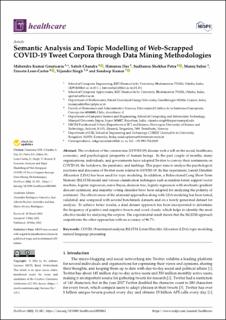Semantic Analysis and Topic Modelling of Web-Scrapped COVID-19 Tweet Corpora through Data Mining Methodologies
| dc.contributor.author | Gourisaria, Mahendra Kumar | |
| dc.contributor.author | Chandra, Satish | |
| dc.contributor.author | Das, Himansu | |
| dc.contributor.author | Patra, Sudhansu Shekhar | |
| dc.contributor.author | Sahni, Manoj | |
| dc.contributor.author | Leon-Castro, Ernesto | |
| dc.contributor.author | Singh, Vijander | |
| dc.contributor.author | Kumar, Sandeep | |
| dc.date.accessioned | 2023-01-20T08:36:21Z | |
| dc.date.available | 2023-01-20T08:36:21Z | |
| dc.date.created | 2022-08-24T13:22:38Z | |
| dc.date.issued | 2022 | |
| dc.identifier.citation | Healthcare. 2022, 10 (5), . | en_US |
| dc.identifier.issn | 2227-9032 | |
| dc.identifier.uri | https://hdl.handle.net/11250/3044810 | |
| dc.description.abstract | The evolution of the coronavirus (COVID-19) disease took a toll on the social, healthcare, economic, and psychological prosperity of human beings. In the past couple of months, many organizations, individuals, and governments have adopted Twitter to convey their sentiments on COVID-19, the lockdown, the pandemic, and hashtags. This paper aims to analyze the psychological reactions and discourse of Twitter users related to COVID-19. In this experiment, Latent Dirichlet Allocation (LDA) has been used for topic modeling. In addition, a Bidirectional Long Short-Term Memory (BiLSTM) model and various classification techniques such as random forest, support vector machine, logistic regression, naive Bayes, decision tree, logistic regression with stochastic gradient descent optimizer, and majority voting classifier have been adapted for analyzing the polarity of sentiment. The effectiveness of the aforesaid approaches along with LDA modeling has been tested, validated, and compared with several benchmark datasets and on a newly generated dataset for analysis. To achieve better results, a dual dataset approach has been incorporated to determine the frequency of positive and negative tweets and word clouds, which helps to identify the most effective model for analyzing the corpora. The experimental result shows that the BiLSTM approach outperforms the other approaches with an accuracy of 96.7%. | en_US |
| dc.language.iso | eng | en_US |
| dc.publisher | MDPI | en_US |
| dc.rights | Navngivelse 4.0 Internasjonal | * |
| dc.rights.uri | http://creativecommons.org/licenses/by/4.0/deed.no | * |
| dc.title | Semantic Analysis and Topic Modelling of Web-Scrapped COVID-19 Tweet Corpora through Data Mining Methodologies | en_US |
| dc.title.alternative | Semantic Analysis and Topic Modelling of Web-Scrapped COVID-19 Tweet Corpora through Data Mining Methodologies | en_US |
| dc.type | Peer reviewed | en_US |
| dc.type | Journal article | en_US |
| dc.description.version | publishedVersion | en_US |
| dc.source.pagenumber | 0 | en_US |
| dc.source.volume | 10 | en_US |
| dc.source.journal | Healthcare | en_US |
| dc.source.issue | 5 | en_US |
| dc.identifier.doi | 10.3390/healthcare10050881 | |
| dc.identifier.cristin | 2045635 | |
| cristin.ispublished | true | |
| cristin.fulltext | original | |
| cristin.qualitycode | 1 |
Files in this item
This item appears in the following Collection(s)
-
Institutt for IKT og realfag [599]
-
Publikasjoner fra CRIStin - NTNU [38484]

